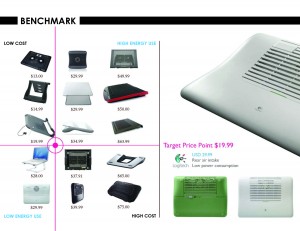Market Research
Often product designers are tasked with researching and defining areas of opportunity within the current marketplace. It’s always important to clearly define a real problem and use your findings to support your design direction. Holistic product development calls for an array of research techniques to limit any ambiguity or question you may have about your user. One technique I would like to highlight is the use of product matrices.
Product matrices help clients or businesses present products in the current market. Placing product price point versus functionality into quadrants; either vector can be defined by goals and subject matter of the project. However this tool is to be looked at as a step in conjunction with ethnographic research, user segmentations, brand language and preliminary findings. Human centered design fuses classic design research with contemporary techniques of engaging the users at all levels of development. The image below showcases an example of product matrices.
Setting up your own product Benchmark metrics
Define your goals by selecting subject matter for your quadrants: features vs cost, height vs accessibility. I always feel it’s best to define your quadrants by making a list and coming back to your original hypothesis. This system helps to define your qualitative research. See image below.
Below is an example of Benchmark metrics comparing cost vs energy consumption. By defining a competitive product, the design team can translate this information into design language. Looking at where products fall into the desired quadrants and what common traits are shared by those selected products. This information can be very reliable to make informed design decision.

